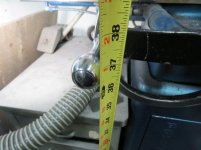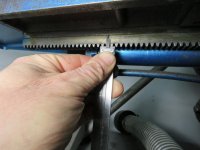Joe Michaels
Diamond
- Joined
- Apr 3, 2004
- Location
- Shandaken, NY, USA
Last winter, I swapped my Sanford surface grinder for a Boyar Schultz 612 Challenger surface grinder. The reasons for this was to get increased capacity. The Boyar Schultz grinder had an unknown and checkered past from all indications. Due to health issues, I was unable to get around to working on this grinder until recently. Overall the grinder seemed like a tight machine, with a few issues. As I cleaned up and put things to rights on this grinder, I realized a Boyar Schultz surface grinder is the equivalent of a "Yugo" when compared to the likes of Brown & Sharpe, Reid, and others. For my purposes, it will be a fine grinder.
The issue which as proved to be something of a conundrum for me is the pinion for the table feed. This pinion is a spur gear, engaging a rack on the underside of the table. Apparently, a previous owner had the machine apart and had lost the original pinion. He then put in an 'off the shelf' pinion, but the result was a 'notchiness' as the pinion engaged the rack.
I took this pinion off and determined it to be a 16 pitch x 18 tooth gear. That was the easy part. I then started to measure the pinion teeth using my gear tooth vernier. The thickness across the pitch point and tooth depth all coincide with both 14 1/2 degree & 20 degree pressure angle gear teeth. I bought a 20 degree PA x 16 tooth pinion on eBay and it was exact in overall dimensions (width, hub diameter & bore) to what was on the grinder. The result was the same 'notchiness' and rough movement of the table. It took some effort on the handwheel to crank the table thru its travel, rather than having it gliding smoothly.
I had found the original electro-mechanical lubricator was incomplete when I got the grinder. I fitted a used Bijur electro mechanical lubricator to the grinder, and changed the drive motor to increase the frequency of 'shots' of way lube. I first ran some "Marvel Mystery Oil" thru the lubrication system and broke lines at various fittings to be sure the lubrication lines were cleared and had good flow. In taking things apart to check lubrication lines and do some cleaning, I did notice the scraping on most of the sliding surfaces was still pretty much all there. With the lubrication issue resolved, I turned back to the table feed pinion.
OK, sez I, let's see where the teeth are hitting hard when they engage the rack. Having two identical pinions, I could sacrifice one to trying to get a better running rack & pinion set. The rack teeth look to be 'stub' teeth. I first determined the pinion was a little on the large side for outer diameter, so set it up in the lathe and skimmed about 0.015" (total) off the OD. No improvement in how things ran. I then figured that with a skim cut on the OD, the corners of the teeth were likely too sharp. I used my die filer to put a small radius on the tips of each tooth where the flanks met the crests. Again, no improvement.
I then figured to open up the running clearance, so using the die filer, skimmed a bit off the flanks of each tooth, working the gear in a curve to try to maintain the involute profile (fat chance of that). The result is the notchiness has turned into more of a rumbling with some slight vibration when the table is moved.
The question in my mind is whether I need to cut a 14 1/2 degree PA x 16 pitch x 18 tooth pinion with full-profile teeth, using the appropriate gear cutter, or, should I use a 16 pitch cutter made for cutting 135- rack teeth ? I ran gear tooth math using my 'Machinery's Handbook", with the voices of my machine design teacher and advanced machine shop teacher back at Brooklyn Technical HS running thru my mind. I've done very little actual gear design over the course of my career, but a simple spur gear pinion should not be such a conundrum. I am guessing the last guy grabbed a 20 degree PA pinion and since it fit in terms of number of teeth and overall dimensions, ran with it. My other guess is, by process of elimination, a 14 1/2 degree PA pinion is what's needed. I figure I may as well cut my own pinion so I can play around with OD & tooth depth. I also figure that, instead of steel (as the pinions I do have are), I will make the new one out of bronze.
I would appreciate some help in determining which number cutter to get. The obvious choice is the cutter number 6 ( 17-20 teeth), but the fact this pinion engages a rack with what appear to be stub teeth has me wondering whether a number 1 cutter ( 135 teeth-rack) should be used. It's a question I never had to deal with in the 56 years since I first cracked the "Machinery's Handbook" snd over the ensuing years of my career and 'retirement'. I appreciate the considered wisdom of everyone here, and wish everyone the best for this Holiday Season.
The issue which as proved to be something of a conundrum for me is the pinion for the table feed. This pinion is a spur gear, engaging a rack on the underside of the table. Apparently, a previous owner had the machine apart and had lost the original pinion. He then put in an 'off the shelf' pinion, but the result was a 'notchiness' as the pinion engaged the rack.
I took this pinion off and determined it to be a 16 pitch x 18 tooth gear. That was the easy part. I then started to measure the pinion teeth using my gear tooth vernier. The thickness across the pitch point and tooth depth all coincide with both 14 1/2 degree & 20 degree pressure angle gear teeth. I bought a 20 degree PA x 16 tooth pinion on eBay and it was exact in overall dimensions (width, hub diameter & bore) to what was on the grinder. The result was the same 'notchiness' and rough movement of the table. It took some effort on the handwheel to crank the table thru its travel, rather than having it gliding smoothly.
I had found the original electro-mechanical lubricator was incomplete when I got the grinder. I fitted a used Bijur electro mechanical lubricator to the grinder, and changed the drive motor to increase the frequency of 'shots' of way lube. I first ran some "Marvel Mystery Oil" thru the lubrication system and broke lines at various fittings to be sure the lubrication lines were cleared and had good flow. In taking things apart to check lubrication lines and do some cleaning, I did notice the scraping on most of the sliding surfaces was still pretty much all there. With the lubrication issue resolved, I turned back to the table feed pinion.
OK, sez I, let's see where the teeth are hitting hard when they engage the rack. Having two identical pinions, I could sacrifice one to trying to get a better running rack & pinion set. The rack teeth look to be 'stub' teeth. I first determined the pinion was a little on the large side for outer diameter, so set it up in the lathe and skimmed about 0.015" (total) off the OD. No improvement in how things ran. I then figured that with a skim cut on the OD, the corners of the teeth were likely too sharp. I used my die filer to put a small radius on the tips of each tooth where the flanks met the crests. Again, no improvement.
I then figured to open up the running clearance, so using the die filer, skimmed a bit off the flanks of each tooth, working the gear in a curve to try to maintain the involute profile (fat chance of that). The result is the notchiness has turned into more of a rumbling with some slight vibration when the table is moved.
The question in my mind is whether I need to cut a 14 1/2 degree PA x 16 pitch x 18 tooth pinion with full-profile teeth, using the appropriate gear cutter, or, should I use a 16 pitch cutter made for cutting 135- rack teeth ? I ran gear tooth math using my 'Machinery's Handbook", with the voices of my machine design teacher and advanced machine shop teacher back at Brooklyn Technical HS running thru my mind. I've done very little actual gear design over the course of my career, but a simple spur gear pinion should not be such a conundrum. I am guessing the last guy grabbed a 20 degree PA pinion and since it fit in terms of number of teeth and overall dimensions, ran with it. My other guess is, by process of elimination, a 14 1/2 degree PA pinion is what's needed. I figure I may as well cut my own pinion so I can play around with OD & tooth depth. I also figure that, instead of steel (as the pinions I do have are), I will make the new one out of bronze.
I would appreciate some help in determining which number cutter to get. The obvious choice is the cutter number 6 ( 17-20 teeth), but the fact this pinion engages a rack with what appear to be stub teeth has me wondering whether a number 1 cutter ( 135 teeth-rack) should be used. It's a question I never had to deal with in the 56 years since I first cracked the "Machinery's Handbook" snd over the ensuing years of my career and 'retirement'. I appreciate the considered wisdom of everyone here, and wish everyone the best for this Holiday Season.









